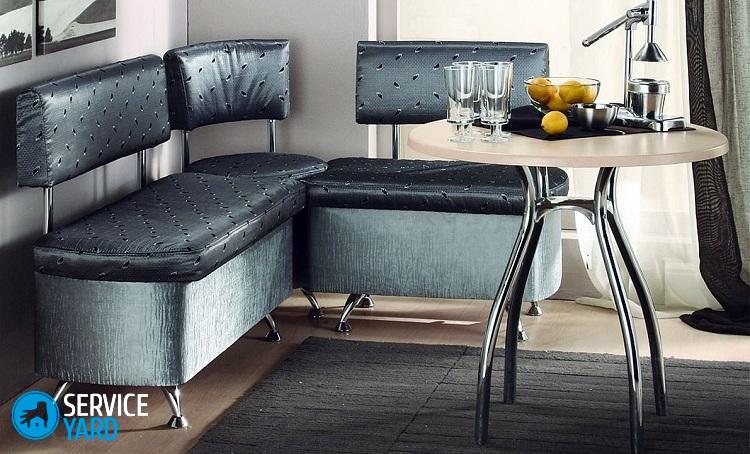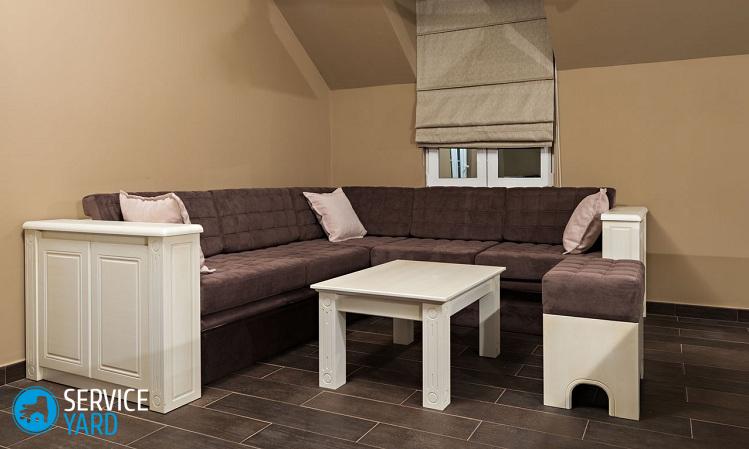Do-it-yourself kitchen corner hauling

A soft corner for the kitchen helps to create a special atmosphere of comfort and coziness. It’s just that it’s not always possible to maintain its presentable appearance for a long time, because drops of fat can spill onto the kitchen furniture, spill wine, fall knives, and the fabric simply erases over time.
One can not do one dry cleaning - hauling a kitchen corner with your own hands will help to achieve a good result. And it’s not at all necessary to order this service in a furniture workshop - you can handle this work yourself, especially if you take into account all the nuances of this procedure, the subtleties of choosing fabrics, cutting upholstery and the sequence of hauling kitchen furniture.
to contents ↑Features of a soft corner banner for the kitchen
The appearance of a soft corner rarely remains attractive for a long time. Often upholstery becomes unusable, which greatly spoils the look of the whole kitchen. It is not necessary to buy a new kitchen corner - just update its upholstery. This simple but creative process is able to completely transform the dining area.
But it is necessary to approach work with all responsibility. First you need to choose the material:
- No matter how you want to take a light velor fabric, first of all, you should think about the practical side of such a material. Since during the use of the sofa more than once coffee can be spilled, tea or an oily stain is accidentally put. Therefore, the potential material for the upholstery of the kitchen corner should be as wear-resistant and easy to clean.
- In addition, the new upholstery should be in harmony with the overall interior of the kitchen. Moreover, it does not have to be ideally combined in color a la “red sofa - to red curtains”, but fit into the overall style of the kitchen. For example, if the room is decorated in the Provence style, then for upholstery, you should choose not artificial leather, but soft textiles. If it is Hi-tech, then a leather sofa here will be more appropriate than a corner upholstered in tapestry.
Material selection
Regardless of what material was originally used for upholstering a kitchen corner, any suitable fabric can be used to constrict it. This will make it possible not only to update the interior, but to use a more wear-resistant type of material. Today, the choice of materials in stores is simply gorgeous - from jacquard and tapestry to genuine leather.
Textile materials
This is the widest group of fabrics, among which you can choose the most suitable material for texture and color:
- Tapestry is a rather dense wear-resistant material that was specially created for upholstery of upholstered furniture. Its advantages include high durability and a variety of color solutions.
- Velor is also a fairly durable material with a short and dense pile. It looks very nice, but there is one drawback - over time, the fibers can be wiped off, so the soft corner will no longer look so presentable.
- Flock is a good fabric for upholstery in a kitchen corner. The material itself is durable and resistant to mechanical stress, and a special moisture-resistant impregnation makes it possible to easily eliminate dirty stains that will necessarily appear on the upholstery.
- Jacquard - beautiful and very pleasant to the touch.Its disadvantage is that it wears out pretty quickly. In addition, removing stains from such material is quite difficult.
Faux leather
Often, high-quality artificial leather is used to constrict the kitchen corner with their own hands. In structure, properties and appearance, it is not much inferior to natural, while it is much cheaper. But, unfortunately, it has its drawbacks - since the dense material does not “breathe”, sitting on it in hot weather is not comfortable. If you choose high-quality thin artificial skin, then it can very quickly wipe, become cracked or torn.
Therefore, it is very important to choose the right leatherette for hauling a soft corner. It is worth paying attention to one of the following materials:
- PU leather - very similar to genuine. It is distinguished by special strength, softness, resistance to mechanical damage, heat resistance and elasticity.
Important! Such high performance properties can be achieved due to a three-layer material, where the first layer is cotton, the second is genuine but defective leather, and the third is polyurethane.
- MF leather. More expensive material that is difficult to distinguish from genuine leather. This coating repels water, is odorless and resistant to mechanical stress. It is very easy to remove any stains from it, and sitting on such material is comfortable due to the basis of “breathing” microfibers.
- Eco leather. Another good material that is made on the basis of polyurethane is completely safe, so it has no smell and does not cause allergies. Another advantage is softness to the touch and elasticity.
- PVC leather is a material that is often used in the furniture industry. It costs less than other types of leatherette. Its performance is also good: elastic, durable, easy to care for and can be draped.
Important! Here are just VPC skin or, in other words, polyvinyl chloride, applied to a fabric base, can emit fumes that are unsafe for health. If possible, it is better to abandon its use.
Genuine Leather
Genuine leather is the most expensive and presentable material for making a kitchen corner with your own hands. It fits perfectly into the modern interior, emphasizing the good taste and wealth of the owners of the house.
However, it is this type of upholstery that requires a very careful attitude:
- It must not be located close to heat sources (stoves, stoves, central heating batteries).
- It requires delicate and thorough cleaning with special detergents.
to contents ↑Important! In addition, mechanical damage, for example, an accidentally dropped knife, can cost the owners very expensive.
Cut new upholstery
The well-known proverb about the need to measure seven times and only then cut off in the case of hauling a soft corner for the kitchen is more relevant than ever. Moreover, you need to know some nuances of how to properly measure and cut out a new upholstery. So, when working, follow this phasing:
- Remove the old upholstery from the corner.
- Using a tape measure or tape measure all the parameters of the cuts - the width and height of the pieces of fabric. Take all measurements along the maximum length of the bends.
- After the measurements are taken, and the new material is purchased, go directly to the cutting. To do this, lay the fabric in one layer, and place pieces of the old upholstery on top of it. Circle the contours of the cuts on a new canvas with a special chalk - this strip will be easily removed while wiping the fabric with a slightly damp cloth.
Important! It is also advisable to leave approximately 5 cm on each side of the hem.
- If you have a plain fabric with a clearly defined pattern, then make sure that on the cuts that will be next to each other, the pattern is combined. Also, during the cutting process, determine the so-called shared thread - the fabric tension thread.Make sure that in all areas of the material such a thread is located in one direction, for example, everywhere in height or width.
to contents ↑Important! Incorrect calculation of the fabric can reduce all work to nothing and turn into unnecessary expenses. Therefore, the novice master needs to make the most accurate calculation of the material as follows: take any unnecessary old fabric on which to lay out pieces of the old upholstery. After that, measure how long and width a piece of new fabric is needed.
What tools will be required to work?
Gently, beautifully and quickly pulling a kitchen corner with your own hands is possible only if the master has all the necessary tools. In particular, the following will be required for work:
- An ordinary knife, an anti-stapler, or a flat screwdriver to pull out staples while removing old furniture upholstery.
- Paint knife for cutting fabric.
- Hammer.
- Sewing machine.
- Carob keys needed to disassemble the furniture frame.
- Furniture stapler for fixing to the frame of the new upholstery.
- Glue for foam rubber.
- Hardware.
to contents ↑Important! It remains to add that for work it is necessary to prepare a sufficient amount of selected fabric material, as well as foam for upholstery.
Step-by-step instructions on how to drag a kitchen corner
The work of hauling a soft kitchen corner cannot be called too complicated, but perseverance, perseverance and knowledge will be very useful to you. Let's understand in more detail how to sheathe a kitchen corner:
- First remove the old upholstery. The fastest way to do this is with the help of an anti-stapler. If you don’t have one, then an ordinary knife or a flat screwdriver will also help to remove all the staples with which the old fabric was nailed to the kitchen corner frame. Also remove the old foam from the wood flooring.
- If the covers are not yet sewn, then now is the time to do it. As mentioned earlier, cut the fabric to the size of the old upholstery. And you can use any material - not necessarily identical to the factory one.
- After the covers are ready, make soft “seats”, in other words, soften the back and seats with foam rubber. The easiest way to use ordinary foam, which is cut into the required size squares with a construction knife.
Important! Foam rubber can be glued to a wooden frame with construction glue or sew it into cut pieces of fabric.
- It remains to directly drag a soft corner. To do this, pull the new covers on the frame and on the back in several places, fix them with the brackets of the construction stapler. At this stage, try not to rush and work carefully, in order to avoid distortions of the fabric.
Important! The distance between the brackets should be no more than 4 cm, otherwise - the material will be worn out, and the work will need to be redone.
- Gather all the details of the kitchen corner into a single whole - with the new upholstery, the sofa will perfectly refresh the interior of your kitchen.
to contents ↑Important! If you have pieces of material left after updating the soft corner, you can use them to update stools or sew small pillows, which perfectly complement the updated furniture and make the kitchen even more comfortable.
Stock footage
Doing the kitchen corner with your own hands is a fascinating and creative activity that can be the final stage of repair in the kitchen. The result will largely depend on the design of the corner, the selected material and your accuracy, so you need to approach the work with all responsibility.
- How to choose a vacuum cleaner taking into account the characteristics of the house and coatings?
- What to look for when choosing a water delivery
- How to quickly create comfort at home - tips for housewives
- How to choose the perfect TV - useful tips
- What to look for when choosing blinds
- What should be running shoes?
- What useful things can you buy in a hardware store
- Iphone 11 pro max review
- Than iPhone is better than Android smartphones





